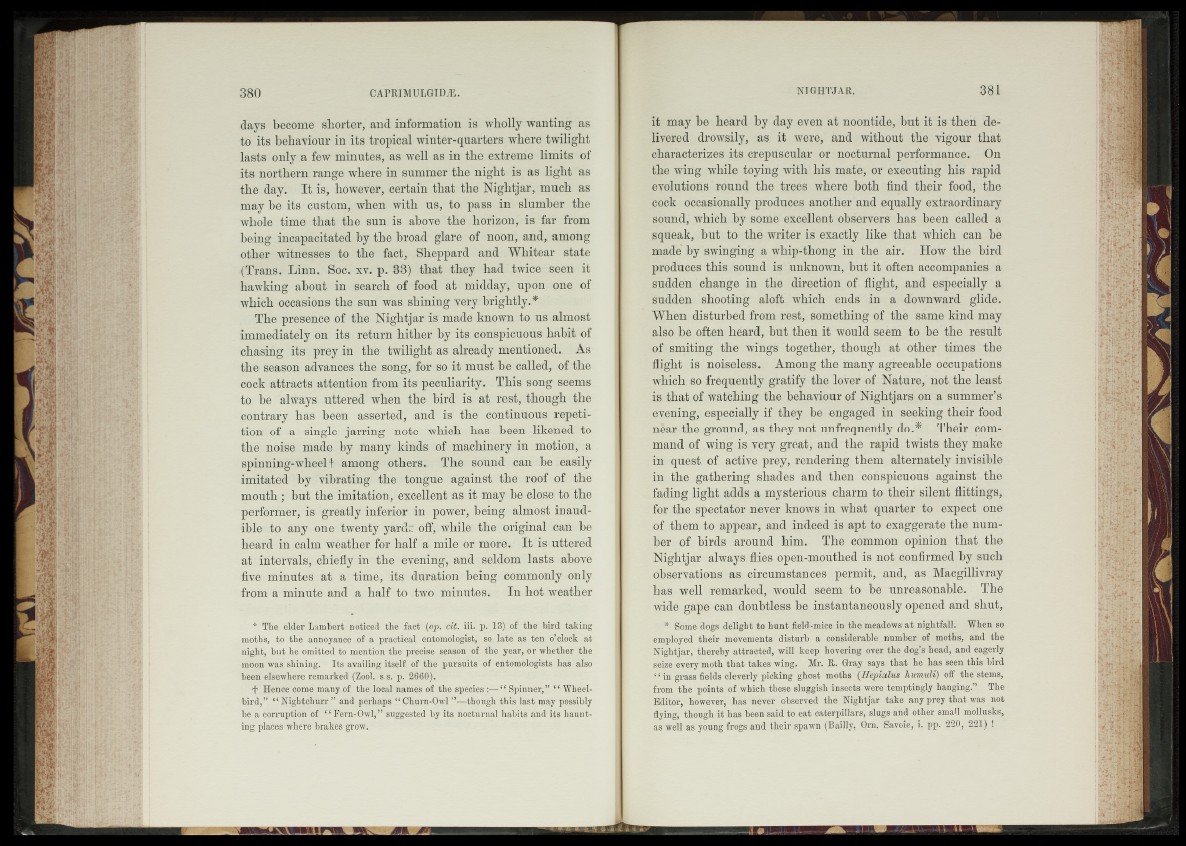
days become shorter, and information is wholly wanting as
to its behaviour in its tropical winter-quarters where twilight
lasts only a few minutes, as well as in the extreme limits of
its northern range where in summer the night is as light as
the day. It is, however, certain that the Nightjar, much as
may be its custom, when with us, to pass in slumber the
whole time that the sun is above the horizon, is far from
being incapacitated by the broad glare of noon, and, among
other witnesses to the fact, Sheppard and Whitear state
(Trans. Linn. Soc. xv. p. 88) that they had twice seen it
hawking about in search of food at midday, upon one of
which occasions the sun was shining very brightly.*
The presence of the Nightjar is made known to us almost
immediately on its return hither by its conspicuous habit of
chasing its prey in the twilight as already mentioned. As
the season advances the song, for so it must be called, of the
cock attracts attention from its peculiarity. This song seems
to be always uttered when the bird is at rest, though the
contrary has been asserted, and is the continuous repetition
of a single jarring note which has been likened to
the noise made by many kinds of machinery in motion, a
spinning-wheelf among others. The sound can be easily
imitated by vibrating the tongue against the roof of the
mouth; but the imitation, excellent as it may be close to the
performer, is greatly inferior in power, being almost inaudible
to any one twenty yardc off, while the original can be
heard in calm weather for half a mile or more. It is uttered
at intervals, chiefly in the evening, and seldom lasts above
five minutes at a time, its duration being commonly only
from a minute and a half to two minutes. In hot weather
* The elder Lambert noticed the fact (op. cit. iff. p. 13) of the bird taking
moths, to the annoyance of a practical entomologist, so late as ten o’clock at
night, but he omitted to mention the precise season of the year, or whether the
moon was shining. Its availing itself of the pursuits of entomologists has also
been elsewhere remarked (Zool. s.s. p. 2660).
*)* Hence come many of the local names of the species :—“ Spinner,” “ Wheel-
bird,” “ Nightchurr ” and perhaps “ Churn-Owl ’’—though this last may possibly
be a corruption of “ Fern-Owl,” suggested by its nocturnal habits and its haunting
places where brakes grow.
it may be heard by day even at noontide, but it is then delivered
drowsily, as it were, and without the vigour that
characterizes its crepuscular or nocturnal performance. On
the wing while toying with his mate, or executing his rapid
evolutions round the trees where both find their food, the
cock occasionally produces another and equally extraordinary
sound, which by some excellent observers has been called a
squeak, but to the writer is exactly like tha.t which can be
made by swinging a whip-thong in the air. How the bird
produces this sound is unknown, but it often accompanies a
sudden change in the direction of flight, and especially a
sudden shooting aloft which ends in a downward glide.
When disturbed from rest, something of the same kind may
also be often heard, but then it would seem to be the result
of smiting the wings together, though at other times the
flight is noiseless. Among the many agreeable occupations
which so frequently gratify the lover of Nature, not the least
is that of watching the behaviour of Nightjars on a summer’s
evening, especially if they be engaged in seeking their food
near the ground, as they not unfrequently do.* Their command
of wing is very great, and the rapid twists they make
in quest of active prey, rendering them alternately invisible
in the gathering shades and then conspicuous against the
fading light adds a mysterious charm to their silent Sittings,
for the spectator never knows in what quarter to expect one
of them to appear, and indeed is apt to exaggerate the number
of birds around him. The common opinion that the
Nightjar always flies open-mouthed is not confirmed by such
observations as circumstances permit, and, as Macgillivray
has well remarked, would seem to be unreasonable. The
wide gape can doubtless be instantaneously opened and shut,
* Some dogs delight to hunt field-mice in the meadows at nightfall. When so
employed their movements disturb a considerable number of moths, and the
Nightjar, thereby attracted, will keep hovering over the dog’s head, and eagerly
seize every moth that takes wing. Mr. R. Gray says that he has seen this bird
“ in grass fields cleverly picking ghost moths (Hepicclus humuli) off the stems,
from the points of which these sluggish insects were temptingly hanging.” The
Editor, however, has never observed the Nightjar take any prey that was not
flying, though it has been said to eat caterpillars, slugs and other small mollusks,
as well as young frogs and their spawn (Bailly, Orn. Savoie, i. pp. 220, 221) !